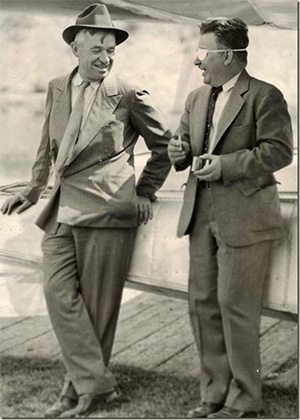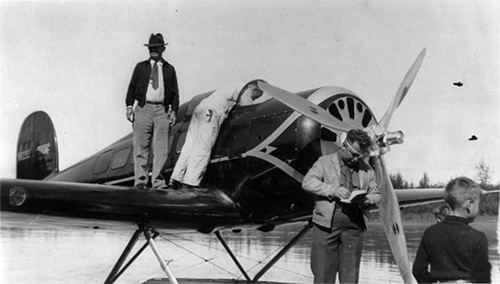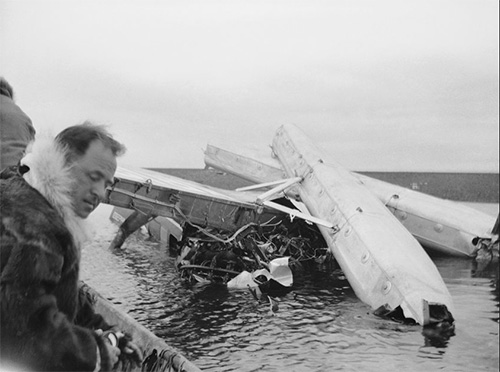
Did a ‘deadhead’ in Funter Bay cause the air crash death of Will Rogers?After 80 years still no clear cause to Alaska’s most famous plane crashBy DAVE KIFFERMarch 29, 2017
The death of famous humorist Will Rogers and his pilot Wiley Post on August 15, 1935 made headlines across the world. Rogers and Post had been making a flight through Alaska and were planning to cross the Bering Sea to Siberia when they crashed. Post was one of the most well-known pilots in the world, having been the first pilot to fly solo around the world and had set multiple speed and altitude records. He was also famous for his eye patch, having lost his left eye in an oil field accident many years before. Post was an aeronautic ‘swashbuckler’ who had actually served time for bank robbery before discovering aviation and turning his life around. Rogers was likely the most famous man in America in the 1920s and 1930s, an entertainer and a syndicated humorist whose columns were carried more than 1,000 newspapers. Even today, 80 years after his death he is still considered one of the most trenchant observers of the American scene and his one-liners are still frequently quoted. Some of the more famous Will Rogers quotes? “A fool and his money are soon elected.” “I am not a member of any organized political party. I am a Democrat.” “Diplomacy is the art of saying ‘nice doggie’ until you can find a rock.” “Good judgment comes from experience and a lot of that comes from bad judgment.” “There are three kids of men. One that learns by reading. A few that learn by observation. And the rest of them have to pee on the electric fence for themselves.” In 1935, he was at the height of his fame, having successfully transitioned to the newest mass media, radio, with weekly programs that were heard by nearly every American. He had also appeared in more than 50 movies in the 18 years prior to his death. In fact, Rogers first met Post – a fellow Oklahoman and fellow Cherokee – when Post was transporting film for movie companies. Rogers had always been a strong proponent of the aviation industry and planned to write columns boosting it during his flight with Post. It was a time when very few Americans had flown and Rogers believed it to be the wave of the future. With Alaska, then as now, having few runways, Post made the decision to equip his Lockheed Orion monoplane with floats. Post’s plane, one of the most powerful in the world at the point, had already been modified with a wing from a Lockheed Explorer.
Rogers standing on the wing of the seaplane, with Wiley Post standing in front of the propeller, August 1935 at Fairbanks.
In fact, the office Department of Commerce report – air traffic was then responsible to the Bureau of Air Commerce – issued after the crash specifically blamed the change from wheels to pontoons for the accident. “Prior to the flight…the airplane was completely rebuilt and several major changes incorporated which changed it from the original model,” the report of the Accident Board, Jesse M. Lankford, Secretary, stated. “The engine, propeller, wings and fuel tanks were changed entirely.” The report noted that the plane was inspected after those changes and was certified as airworthy for long distance and special test flights But after the pontoons were added in Seattle, there was no inspection or certification, according to the report. “A study of the effect of the various changes made on the airplane indicated that it was decidedly nose-heavy and must have been extremely difficult, if not impossible, to properly control without the aid of an engine,” the report continued. “A statement made by the pilot after the change to pontoons confirms this conclusion.” That statement was apparently made to fellow pilot Joe Crosson in Fairbanks according to aviation author Bryan Sterling who noted that “Wiley Post never really liked the new plane” primarily because it was a combination of parts that “produced an uncontrollable nosedown pitching movement at low air speeds and low power settings. Still, Rogers and Post continued on with their journey, according to Sterling. Rogers particularly expressed confidence in Post and the airplane. Earlier, when Post went to the Lockheed factory in California to discuss floats for the Orion, Lockheed said no, according to Alaskan aviation historian Archie Satterfield in his 1964 book “Alaska Bush Pilots in the Float Country.” “Lockheed refused, saying floats would ruin the aerodynamic integrity, make the nose heavy and in the event of a slight power loss on takeoff, would mean serious trouble,” Satterfield wrote. “Post was irritated and unimpressed with their warning.” Post and Rogers flew on to Seattle, where he found a set of floats to install on the Orion. Which takes us back to Funter Bay. Several weeks before the Rogers/Post flight, there had been an accident at Funter Bay. Alex Holden, another legendary early Alaskan pilot, was flying a Pacific Alaska Airways Fairchild 71 from Juneau to Funter Bay. When he landed the floatplane he encountered one of the most common float plane threats. A “deadhead” in the water. Deadheads are floating logs that often nearly impossible to see from the air and when a float plane hits one on either landing or takeoff, the results can be catastrophic. In this case, Holden and his passenger Lloyd Jarman were lucky not to be seriously injured, but the Fairchild’s floats were damaged enough that they had to be sent to Seattle, to Northwest Air Service, for repairs. And that’s where the pair of EDO 3500 floats were when Post and Rogers arrived in Seattle. Post had reportedly ordered a pair of floats to be installed in Seattle, but they had not arrived. Fortunately, the EDO 3500 floats were available. The floats were owned by Pacific Alaska Airways and Post contacted his friend, yet another legendary Alaska pilot, Joe Crosson, about using them on his Lockheed. Satterfield wrote that Crosson was not aware that Lockheed had said no on the floats and gave permission to Northwest Air Service to install them on the Lockheed. According to Will Rogers Jr, Post and Rogers tested the new floats several times on Lake Washington and were happy with their performance. The two men left for Alaska on August 6th and then flew on to Fairbanks, where they visited with Crosson and other friends. According to Sterling, Crosson expressed some concern with the nose heaviness of the airplane. He also expressed concern about the recent weather north of Fairbanks. But on August 15, Post and Rogers left Fairbanks to fly to city of Barrow (now Utqiagvik), but became lost in fog. After navigating by instruments, they realized they were lost and began looking for a break in the clouds to put down. They managed to land in a lagoon about 15 miles from Barrow and asked a group of Inupiat hunters for directions. “When they took off, the engine failed, as Lockheed officials had feared, the plane fell off on one wing into the water and flipped on its back, killing both (men) instantly,” Satterfield wrote in 1964.
Wreckage of the Will Rogers' plane crash.
But Bryan Sterling, considered by many to the most authoritative source on Will Rogers, contended – in his 2001 book “Forgotten Eagle: Wiley Post: America’s Heroic Aviation Pioneer” that modern studies have determined that the borrowed floats on the plane were within the specifications and did not necessarily make the plane more nose heavy. Sterling contended that the plane was only 50 feet off the ground when the engine failed and would have been unable to recover anyway. According to Sterling the main problem was that governmet inspectors should have looked at the plane after the float modification to make sure it was safe to fly and they didn’t. At any rate, there was no official determination about what caused the engine to cut out in the first place. The Commerce accident board report thought cold temperatures might have been a factor even though the crash occurred in August. “The temperature at the time was about 40 degrees and the failure could have been due to the engine having become cool while standing in the lagoon or to ice or water condensate forming in the carburetor. It is the opinion of the Accident Board that the probable cause of this accident was the loss of control of the aircraft at a low altitude after the sudden engine failure, due to the extreme nose-heaviness of the aircraft.” Sterling, though, says the carburetor ice theory is weak because the plane engine was only shut off for 10 minutes, not enough time to cool down and allow ice to form in the above freezing temperature. Sterling says a more likely cause was Post’s relative unfamiliarity with the pump system that moved the fuel from the lower wing to the engine. Post's previous planes had single wings above the cabin and fuel from the tanks used gravity feeds rather than pumps and we less susceptible to engine cut out from low fuel levels. Sterling believes that Post may have allowed the fuel tank to get too low and did not switch to another tank as he should have before attempting to take off in the lagoon. After the crash, sightseers began flocking to the sight to take parts of the plane. Wiley Post’s wife eventually arranged for the entire plane – and the controversial floats – to be destroyed.
Contact Dave at dave@sitnews.us Dave Kiffer ©2017
Publish A Letter in SitNews Read Letters/Opinions
|
|||


